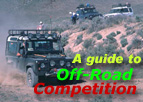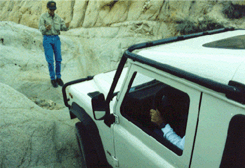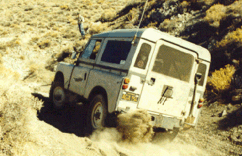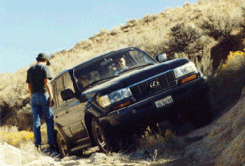|
Welcome to ORE! |
|
||
|
|
|||
|
|
|||

|
Back to Off-Road Driving Tips Page 1 16) When ground conditions appear difficult, such as rocks, ruts, etc., it is advisable to select a path by foot prior to driving through, thus reducing the chance of getting stuck or damaging your vehicle. The use of a spotter is also recommended.
17) Exercise care when applying the throttle. Excess throttle will cause wheel spin (digging) and could stop forward movement. Don’t dig with your wheels, otherwise you’ll be digging with a shovel! 18) Momentum of a fast moving vehicle will always overcome the drag and reduce the traction needed from the wheels. When it is clear that NO obstacle is in the way to cause damage, a fast approach to a steep hill, soft sand, mud, etc., can very often be effective.
19) When crossing ditches, ruts, logs, etc., always try to keep as many wheels as possible on the same type of surface. Avoid getting the wheels airborne. Also ditch & log crossing should be done at 45-degree angles, not head on, thus keeping traction loss to one wheel only. 20) Always be aware of obstacles under your vehicle, keeping in mind you only have so much ground clearance. Avoid existing deep ruts, sudden changes in slopes, plus remember your approach and departure angles.
21) Maximum advisable wading depth is approx 20-inches. If equipped, fit the bellhousing wading plug prior to setting out. Make sure your engine air intake does not suck water, otherwise great engine damage will occur. Though some vehicles are known for driving through deep water, we don’t suggest it (you need specialized vehicles & equipment). If you have to cross that stream, survey it first. If the water is glass smooth and you can’t see the bottom, a muddy bottom is usually the norm. If choppy and rough, rocks are then the cause. When surveying you’ll have to check depth, current speed, condition of the stream bottom (does it offer traction or not?). Don’t try driving against the current, and if you have to cross, take it a right angles, or angle your way down stream to the opposite bank, letting the current help you along. You are in... don’t splash, this will normally cause an engine to be soaked (causing it to quit, or suck water down the air cleaner). Begin slowly and create a "bow-wake", taking care to keep a steady speed. 22) After driving through deep water (or mud), make sure your brakes are dried out immediately, thus being fully operational when needed. This can be done by driving a short distance with the brake pedal applied lightly. You should also check your air filter for water. 23) When dealing with mud, refer to #10, 13, 14, 15, 16, 17 & 18 for starters. Now think about what gear you’ll use, we normally try second gear low-range (possibly 3rd with a V8 & automatic), keep a steady speed, not too fast, and try not to spin the wheels, as if they are, you are not going forward. If you loose forward movement, lift off the throttle slightly, enough to stop the spinning and see if you regain traction, normally you well. Throttle control and traction is the key to driving in the mud. 24) Should you get stuck, careful thought and experience will usually provide a solution. However, the trick is not to get stuck in the first place. The idea of having a winch is great, but just in case you don’t have one, look at your situation, then clear any/all obstacles from in front of all four tires. Adjust air pressure as necessary, then begin a rocking motion (forward-reverse, etc.). In most cases it will do the trick. If not, it may be necessary to jack up the car and place rocks, matting, etc., under the tires for added traction. It may also be necessary to remove all payload from the load space area. 25) Driving in the snow can be a daily chore for some, or fun for others. The problem isn’t the snow, but the ice under it. Let’s talk freeway snow driving: You’re headed east for Reno over Donner Pass, the summit is some 7300 feet above sea level, the snow line begins a 3000 feet, the CHP has a chain requirement up and is advising all to stay away. So what do you do? Head for the mountains no doubt. Whether you are going skiing for the weekend, or on business, if the CHP has warnings and requirements up, stay home! That cures that, right? No? Like most you’ll go anyway, clogging the roads for all those that have to get across. Don’t, stay home... please. So you run into driving snow at 3000 feet, by 4000 Cal-Trans has the road blocked checking for chains or 4wds with snow tires (see #26). From this point on the road is white, your vehicle type will have a lot to do with whether or not you’ll have an easy time of it. Lets take a Range Rover first, post-’88 with a viscous coupler transfer (these vehicles are full-time 4WD). Really you don’t have to do a thing, just drive it. For example, if you’re in a Land Rover Discovery or Defender, or a pre-’89 Range Rover, these are fitted with a manual center-diff-lock (still full-time 4WD), and when encountering slick areas such as snow covered roads (or mud), the center-diff must be locked to obtain maximum traction. Leave it locked until blacktop appears from under the snow and traction has be regained (center-diff-lock may be operated at any speed). Now you’re driving a ‘96 Trooper with a V6, or a Honda Passport, now what? It’s in 2WD most of the time, and engaging 4WD on a snow covered road requires slowing and/or stopping in order to engage high-range 4WD (read your manual). Now, some of these vehicles limit the speed in which you can travel in 4WD high-range (meaning highway speed ratio), thus you’ll again have to research such things with your dealer. Anyway, 4WD must be engaged otherwise you’ll have no traction, thus no control, and possibly no forward movement. In fact, the CHP could require you to fit chains, or worse yet, turn back. The Bravada, and vehicles like it, the owner should be concerned when in snow conditions, as though they are built as a street type 4-wheeler, and are not an off-road vehicle, and can do quite well in snow conditions (plowed) with the right tires fitted, they still have no low-range capabilities, thus in extreme conditions can be no better than the average car fitted with chains. As said earlier, the snow isn’t so much the problem, except visibility (keep your lights on low-beam, no driving lamps, but fog lamps okay -yellow even better), its the ice under it. ABS braking is the current fad, and though "ORE" doesn’t endorse ABS as a whole, this is one of the few times they show their worth. Driving in the snow is like racing motorcycles in the rain... you have to be smooth. Don’t use abrupt throttle openings, heavy braking, or quirky steering movements. Apply the throttle smooth and steady. Do all your braking in a straight line (release the pedal prior to making your turn). If in a bad situation, do not lock the wheels up with the brakes! Down shift as necessary, engine braking will slow the vehicle straight and smooth in most cases. Make your turns in a nice smooth arch, don’t jerk the wheel. Think egg shells. Remember that braking distances have increased ten fold, thus you’ll have to adjust your driving habits... don’t follow so close (as you might do in commute traffic), stay off the brakes if at all possible - down shifting instead of constantly dragging on the brakes; stay in one lane - changing lanes can be deadly due to berms of built up snow between the lanes. If you’re spooked about driving in adverse conditions you have two choices; a) stay home, or b) take one of our classes that deal with such. Here’s a little story.... A gentleman calls about our classes, says he’s just bought a new Jeep, replacing the one he totaled out on Donner during the winter. "What happen?" I asked, "I was coming down the mountains, it was snowing hard, then all of a sudden it spun and I went down an embankment!" he replied. I asked one question of him... "Did you have the brakes on?" "Why yes, and it still wouldn’t stop!". WRONG! No brakes! Lightly if you have to. Here’s another one... The "ORE" crew is heading home on I-80, while Blain passes the Nevada City exit he finds a Toyota 4WD pickup sideways in the road stopped (very dangerous!). Blain stops, gets out and talks with the driver and his wife, both of whom are freezing cold inside, and Blain asks if they need help. They say they can’t get up the grade, "the truck keeps going sideways". Blain asks if the driver has 4WD engaged, the driver replies "yes!". Blain proceeds to ask if the driver has any chains, which are quickly produced, then goes about fitting them (though the tires were marked "M&S", they were not the type that should be in such conditions). Blain completes fitting the chains and instructs the driver to proceed, that he would follow him up the grade, or tow him if needed. With that, the couple crank up their truck, but it won’t move, the rear wheels (one of them) was spinning, but no action up front. Blain has them hold up, then checks the locking hubs up front. Guess what? They weren’t locked! When in doubt, stay home, or... take our class regarding winter time driving. Here’s another one for those with children out and about. During the same driving blizzard that Blain came across the Toyota, John and Michael would come across someone in need as well. Descending down the mountain a set of lights were spotted coming up, it is difficult to tell who’s doing what with all that snow falling. As they approached said lights, they noticed the lights were stationary and off to the right. Moments later they’d find an S10 Blazer backed down into a snow drift, three young college girls inside wondering what to do next. After checking on their health, the age old question of... "do you have it in 4-wheel-drive?" was asked, "I think so" was the reply from with in. "Okay then, put it in second gear and lightly touch the throttle and we’ll see what happens", the rears spun. After engaging 4WD low-range and again applying throttle, the Blazer refused to move, its chassis hung up on the drift. With that now known, the only alternative was to winch them out. With the winching in progress John informed the young ladies of the "ORE" classes and handed them some information, to this day we’ve never heard from them. Normal. Just think about what could have happened had circumstances been only slightly different. Let’s not. Off-roading in the snow can be a blast, though caution is the word of the day. Since your off-road, you can be sure no one has plowed the road or trail ahead. Snow packs quickly when in front, or under your vehicle, a drift of only minor depths can strand you, leaving you with digging and/or winching your way out. When in doubt, survey it. Walk through it, find out how deep the snow is before you drive 5000-pounds of 4WD into it. Though while driving in it, depending on depth and pack, again use smooth throttle, braking and steering methods. Remember that when on a dirt trail/road that the snow will freeze the puddles under it, and every now and again sheets of flying ice may appear as you tear across the surface. |
||||||





